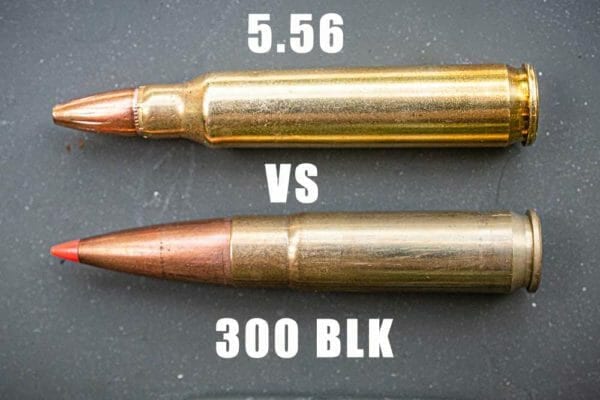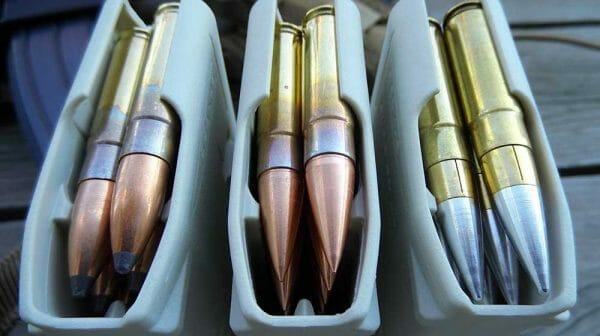AmmoLand writer Logan Metesh examines the history & development of .300 Blackout vs 5.56 NATO ammunition rounds.

U.S.A. –-(AmmoLand.com)- The AR platform is arguably the most popular one on the market right now. Primarily chambered for the 5.56/.223 caliber, the gun has been adapted to a variety of other calibers over the years, but none has gained wider acceptance than .300 Blackout. Let us take a look at the benefits & drawbacks of .300 Blackout vs 5.56 NATO ammunition rounds.
History of 5.56/.223
The genesis of the 5.56 and .223 calibers is the same as many other popular calibers over the years: it was driven by the military.
The era of the heavy-hitting battle rifle had come to an end. The M1 Garand and the M14 rifles were phased out and a new and radically different rifle – the M16 – was coming of age.

ArmaLite’s new rifle design demanded a new caliber, and their initial intention wasn’t to reinvent the wheel. At first, they floated the idea of using the commercial .222 Remington, which was a popular varmint cartridge. Unfortunately, that caliber wasn’t up to military specs, and so they had to go back to the drawing board.

What emerged was a similar yet distinctly different round: the 5.56x45mm developed by James Sullivan, who had worked with Eugene Stoner on the rifle’s design. The cartridge was officially adopted in the US in 1964, and the “civilian” version, known as the .223 Remington, was soon put into production as well.
NATO, however, was not pleased with this new cartridge. Having only recently switched to 7.62x51mm, they were in no hurry to change yet again to another new round that they deemed inferior. Eventually, they relented, and in 1980 the 5.56x45mm cartridge became the NATO standard.
Both the 5.56 and .223 cartridges have proven themselves with the military and civilian markets alike. After almost 60 years of use, it’s safe to say that both are here to stay.
History of .300 AAC Blackout
A relative newcomer, the .300 AAC Blackout turned 10 this year, but it has accomplished quite a lot in just a decade. Work began in 2009 by designer Robert Silvers as a joint venture between Advanced Armament Corporation (AAC) and Remington Defense.

As the story goes, a military customer approached them in 2009 wanting to use standard M4 (AR) bolts and magazines that would retain a 30-round capacity, but fired a .30-caliber projectile. Work continued through 2010 and the cartridge was approved by SAAMI in January 2011.
The result was the .300 AAC Blackout, which stood on the shoulders of an earlier wildcat cartridge known as the .300 Whisper.
Even though .300 Blackout had military-minded roots, no organization has officially adopted it across the board. It has, however, become incredibly popular with AR enthusiasts who are looking for something a little different.
Benefits and Drawbacks of .300 Blackout vs 5.56 NATO
The biggest benefit of 5.56/.223 ammo is its prevalence. Well, at least until the ammo shortage of 2020 began. Whether you roll your own or buy off the shelf every time, there was no problem finding this caliber because it was in use by almost everyone, everywhere.
Run out of ammo at the range? No problem. The pro shop was bound to have boxes in stock. It’s not like you had run out of something obscure, like 10.15x63Rmm.
One of the biggest drawbacks is in terms of sound suppression. Using a suppressor with a firearm in this caliber will certainly bring the decibels down, but it really won’t make them “hearing safe.” And remember: just because you can tolerate the volume doesn’t mean it’s safe. Oh, and if you want to run it on a 7” pistol build? Ha! Forget about it! Better have that ear pro handy!
Benefits and Drawbacks of .300 AAC Blackout
The biggest benefit of the .300 Blackout is that it allows caliber diversity in the AR platform with minimal changes to the gun itself. All you need is a different barrel, and given the LEGO-like qualities of an AR, this is easily swapped out by popping two pins and slapping on a new upper receiver.
You can use the same bolt, same charging handle, and same magazines. If you’re into uniformity, you could outfit an entirely new upper with the same physical setup, just with a different caliber barrel. Pretty nifty.
Where the .300 Blackout really shines, though, is when it is used in conjunction with a suppressor. Subsonic loads are impressively quiet when shot from an AR outfitted with a suppressor. Even with shorter barrel lengths, it still does a great job at keeping the decibels down without sacrificing overall performance.
One drawback to this cartridge is the cost. Even though it’s similar to the 5.56/.223 in many aspects, they part ways at price. You’ll definitely pay more per round for .300 Blackout.
300ACC Ready Uppers at your Favorite Gun Shops
- Sportsman’s Guide .300 AAC Blackout Upper Receivers
- Brownells .300 AAC Blackout Upper Receivers
- Primary Arms .300 AAC Blackout Upper Receivers
“300ACC Danger Will Robinson”
The biggest drawback to this cartridge, however, is also one of its biggest benefits: shared gun parts with 5.56/.223 cartridges. But since the .300 Blackout was designed to fill a regular AR mag to its full capacity, careless loading or a lack of oversight could lead you to grab a mag full of the wrong ammo.

It gets worse, though. You can chamber a .300 Blackout round in a 5.56/.223 barrel, but you absolutely cannot fire it from that barrel without the gun experiencing a catastrophic failure and putting yourself at risk of serious physical harm.
As a result, you’ve got to keep an eye on what rounds you have in what mags, and what upper you’ve got installed on your lower receiver.
.300 Blackout vs 5.56 NATO Which One Wins?
To be completely honest, I’d say it’s a draw. They’re both great for their own purposes and have their respective places. I think picking a true winner depends on personal application. If you’re all about shooting suppressed, .300 Blackout can’t be beaten. If you’re a casual AR enthusiast, then 5.56/.223 is where it’s at.
That said, variety is the spice of life and you shouldn’t have to “Sophie’s Choice” your firearms, so why not own both?
About Logan Metesh
Logan Metesh is a historian with a focus on firearms history and development. He runs High Caliber History LLC and has more than a decade of experience working for the Smithsonian Institution, the National Park Service, and the NRA Museums. His ability to present history and research in an engaging manner has made him a sought after consultant, writer, and museum professional. The ease with which he can recall obscure historical facts and figures makes him very good at Jeopardy!, but exceptionally bad at geometry.

